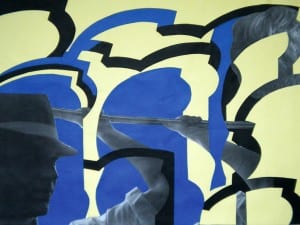A new exhibition of renowned architect Zaha Hadid (1950-2016) showcases not only a practice as a structural designer, but also reveals her work created as an artist. Regarded as a pioneering and visionary figure in her field, a representation of her paintings and drawings at Serpentine Gallery sheds a new light on the Iraqi-born British architect.
In 2004, Hadid became the first woman to win the Pritzker Architecture Prize, alongside being awarded the UK’s most prestigious architectural award, the Stirling Prize, in 2010 and 2011. Furthermore, in 2012 she was made a Dame, and in 2015 became the first woman to be given the Royal Gold Medal from the Royal Institute of British Architects.
Conceived in partnership with the artist, the show places calligraphic drawings at the very heart of her 36-year career, including etchings from private notebooks that expose complex thoughts about architectural forms and their relationships. Focusing on early pieces from before her first building was commissioned in 1993, the Vitra Fire Station in Germany, Serpentine sources sketches and illustrations from the 1970s to the early 1990s that acted as the foundations to an internationally successful practice.
Influenced by Malevich, Tatlin and Rodchenko, the drawing and paintings have been fundamental to Hadid’s achievements, using intricate design patterns to visualise her architectural plans. Painting was used as an essential tool within the process an abstract and investigative medium for imagining the structures- and their relations to the world in which we live. Works on paper and canvas unravel a secret mechanical vocabulary, a language that she was determined to realise within buildings, with the lightness and weightlessness of the drawings becoming characteristic in her three-dimensional forms.
Hadid stated in 2007: “I have always been interested in the concept of fragmentation and with ideas of abstraction and explosion, de-construction ideas of repetitiveness and mass production. My work first engaged with the early Russian avant-garde, in particular with the with the work of Kasimir Malevich, whose abstract work allowed for much greater levels of creativity”.
Regarded as Hadid’s manifesto of a utopian world, the show discloses all-encompassing visions of arranging space and interpreting realities. Many of the pieces in the exhibition pre-empt the potential of digital and virtual realities. Patrik Shumacher, Director of Zaha Hadid Architects, notes: “It was Hadid who went first and furthest in exploring this way of innovating in architecture-without, as well as with, the support of advanced software.”
Zaha Hadid: Early Paintings and Drawings, Serpentine Gallery, London, 8 December-12 February. Find out more: www.serpentinegalleries.org
Find us on Facebook and Twitter @Aestheticamag
Credits
1. Zaha Hadid, Heydar Aliyev Center, Azerbaijan (2012)




